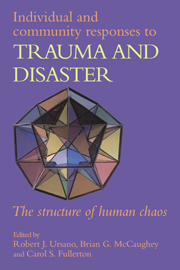Book contents
- Frontmatter
- Contents
- List of contributors
- Foreword
- Preface
- Part I Introduction
- Part II The nature of traumatic stress
- 2 The psychology of terror and its aftermath
- 3 Exposure to traumatic death: the nature of the stressor
- 4 Psychological and psychiatric aspects of technological disasters
- 5 Traumatic effects of accidents
- 6 The human experience of earthquakes
- 7 Psychological effects of toxic contamination
- Part III The role of psychosocial context in responses to trauma and disasters
- Part IV Responses to trauma across the life cycle
- Part V Conclusions
- Index
6 - The human experience of earthquakes
from Part II - The nature of traumatic stress
Published online by Cambridge University Press: 13 October 2009
- Frontmatter
- Contents
- List of contributors
- Foreword
- Preface
- Part I Introduction
- Part II The nature of traumatic stress
- 2 The psychology of terror and its aftermath
- 3 Exposure to traumatic death: the nature of the stressor
- 4 Psychological and psychiatric aspects of technological disasters
- 5 Traumatic effects of accidents
- 6 The human experience of earthquakes
- 7 Psychological effects of toxic contamination
- Part III The role of psychosocial context in responses to trauma and disasters
- Part IV Responses to trauma across the life cycle
- Part V Conclusions
- Index
Summary
Destructive earthquakes occur frequently and affect the economic, social, medical, and psychological wellbeing of large numbers of people. Worldwide there are 1 00 000 (Beinin, 1985) to 1 000 000 earthquakes per year (Nichols, 1974); 5 000 000 per year if microearthquakes and tremors are included (Nichols, 1974). Most of these earthquakes go unnoticed, too small to even detect.
Although most earthquakes are harmless to man, either because they are too weak to damage property, or because they occur in nonpopulated areas, many cause considerable destruction, injury, and death (see Table 6.1).
Some of the most destructive earthquakes have occurred in China (Jackson, 1981; Sood, Stockdale & Rogers, 1987). Confirmation of specific details is often difficult to obtain. In China, in 1976, an earthquake reportedly killed 800 000 people (Sood et al. 1987). The amount of destruction was difficult to verify at the time because the information released by the Chinese government was quite limited. Another extremely serious earthquake, but also difficult to verify, occurred in AD 526 in Antioch; 260 000 died (Miln, 1890). The number of deaths that are caused by an earthquake may be very high, but even more people may be physically injured. The February 4, 1976 earthquake in Guatemala, caused 24 340 deaths, but 90 000 people were injured (Beinin, 1985). Acute and chronic psychological distress are characteristic of earthquakes (Leivesley, 1984). This chapter will discuss the psychological impact of earthquakes.
- Type
- Chapter
- Information
- Individual and Community Responses to Trauma and DisasterThe Structure of Human Chaos, pp. 136 - 153Publisher: Cambridge University PressPrint publication year: 1994
- 6
- Cited by

